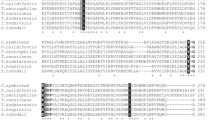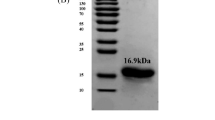Abstract
Fructose 6 phosphate phosphoketolases (F6PPKs) were purified from Bifidobacterium longum BB536, B. dentium ATCC 27534, B. globosum ATCC 25864, and Bifidobacterium animalis ATCC 25527. Concerning ions (Cu++, Zn++, Ca++, Mg++, Fe++, Co++, Mn++) and common enzyme inhibitors (fructose, ammonium sulfate, iodoacetate, and parachloromercuribenzoic acid), no difference appeared between the enzymes. Cu++, parachloromercuribenzoic acid (pCMB), and mercuric acetate induced high enzymatic inhibition. The study of pCMB demonstrated a noncompetitive inhibition. Additional results showed that the sulfhydryl group was not involved in catalytic reaction. Photooxidation experiments and determination of ionizable group pKas (5.16–7.17) suggested the presence of one or more histidines necessary for the catalytic reaction and explained the inhibition observed with pCMB. In light of the noncompetitive inhibition, this group was not directly involved in substrate binding. Determination of K mdemonstrated that the affinities for fructose 6 phosphate in the case of animal and human origin strains were close. In addition, the same enzymatic efficiency (K cat/K m)was obtained for each strain. The F6PPK activity was regulated by sodium pyrophosphate, ATP, and especially by ADP.
Similar content being viewed by others
Literature Cited
Benno Y, Sawada K, Mitsuoka T (1984) The intestinal microflora of infants: composition of faecal flora in breast-fed and bottle-fed infants. Microbiol Immunol 28:975–986
Bourget N, Simonet JM, Decaris B (1993) Analysis of the genome of the five Bifidobacterium breve strains: plasmid content, pulsed-field gel electrophoresis genome size estimation and rm loci number. FEMS Microbiol Lett. 110:11–20
Bradford MM (1976) A rapid and sensitive method for quantification of microgram quantities of protein utilizing the principles of protein dye binding. Anal Biochem 72:248–254
Goldberg M, Fessenden JM, Racker E (1966) Phosphoketolase. Methods Enzymol IX:515–520
Kenyon GL, Bruice TW (1977) Novel sulfhydryl reagents. Methods Enzymol 47:407–430
Laemmli UK (1970) Cleavage of structural proteins during the assembly of the head of bacteriophage T4. Nature 227:680–685
Lipman F, Tuttle LC (1945) A specific micromethod for determination of acyl phosphates. J Biol Chem 159:21–28
Mangin I, Bourget N, Bouhnick Y, Bisetti N, Simonet JM, Decaris B (1994) Identification of Bifidobacterium strains by rRNA gene restriction patterns. Appl Env Microbiol 60:1451–1458
Racker E (1962) Fructose 6 phosphate phosphoketolase from Acetobacter xylinum. Methods Enzymol V:276–280
Scardovi V (1986) Bifidobacterium. In: Sneath HA, Mair NS, Sharpe ME, Holt JG (eds) The bergey's manual of systematic bacteriology, Vol 2, 9th ed. Baltimore: Williams and Wilkins, pp 1418–1434
Scardovi V, Trovatelli LD (1965) The fructose 6 phosphate shunt as peculiar pattern of hexose degradation in the genus Bifidobacterium. Ann Microbiol 15:19–29
Scardovi V, Trovatelli LD, Zani G, Crociani F, Matteuzzi D (1971a) Deoxyribonucleic acid homology relationships among species of the genus Bifidobacterium. Int J Syst Bacteriol 21:276–294
Scardovi V, Sgorbati B, Zani G (1971b) Starch gel electrophoresis of fructose 6 phosphate phosphoketolase in the genus Bifidobacterium. J Bacteriol 106:1036–1039
Schramm M, Klybas V, Racker E (1958) Phosphorolytic cleavage of fructose 6 phosphate phosphoketolase from Acetobacter xylinum. J Biol Chem 233:1283–1288
Sebald M, Gasser F, Werner H (1965) DNA base composition and classification. Application to group of bifidobacteria and to related genera. Ann Inst Pasteur 109:251–269
Sgorbati G, Lenaz Z, Casalicchio F (1976) Purification and properties of two fructose 6 phosphate phosphoketolases in Bifidobacterium. Antonie van Leeuwenhoek 45:557–564
Tissier H (1900) Recherche sur la flore intestinale des nourissons (Etat normal et pathologique). Ph D thesis, University of Medecine, Paris
Weil L, Seibles TS (1955) Photooxidation of crystalline ribonuclease in the presence of methylene blue. Arch Biochem Biophys 54:368–377
Yamamoto T, Marotomi M, Tanaka R (1993) Species specific oligonucleotide probes for five Bifidobacterium species detected in human intestinal microflora. Appl Env Microbiol 58:4076–4079
Author information
Authors and Affiliations
Rights and permissions
About this article
Cite this article
Grill, JP., Crociani, J. & Ballongue, J. Characterization of fructose 6 phosphate phosphoketolases purified from Bifidobacterium species. Current Microbiology 31, 49–54 (1995). https://doi.org/10.1007/BF00294634
Issue Date:
DOI: https://doi.org/10.1007/BF00294634




